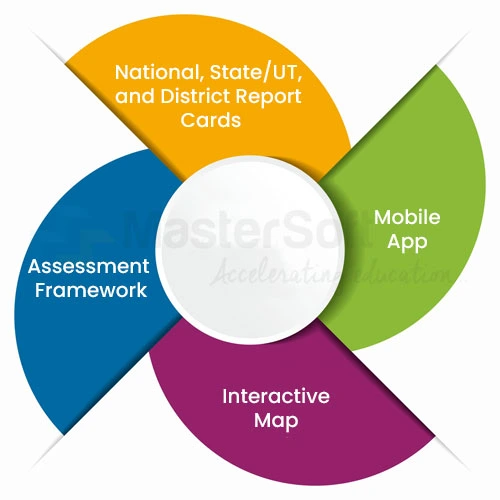01, Jan 2024
The education sector is an important part of our lives. Governments around the world are implementing policies to ensure that every child has access to high-quality education.
The Ministry of Education in India conducts the National Achievement Survey (NAS). It evaluates students' learning levels from across the country. The survey is an important tool for policymakers, administrators, teachers, and parents to make informed decisions about the education system.
Today we will take a closer look at the National Achievement Survey and its objectives. We will also explore the latest version of the survey, NAS 2021, and its scope.
National Education Policy 2020: All You Need To Know About NEP 2020 For Schools
What Is The National Achievement Survey?
National Achievement Survey (NAS) is a large-scale survey conducted by the Ministry of Education, Government of India. It aims to survey and evaluate the learning levels of students on a national scale. This survey provides important information and insights into the effectiveness of the existing school education system.
The NAS is an important tool for understanding and improving India's educational framework. It evaluates the learning levels of students in different subjects and grades across different types of schools.
It also gives insights into the factors that influence student learning, such as school infrastructure, teacher quality, curriculum, pedagogy, and assessment. The NAS helps in addressing the learning gaps and improves the quality of education.
Objectives of the National Achievement Survey
The primary goal of the National Achievement Survey is to evaluate students' learning outcomes in important education subjects.
These are the main aims of the NAS:
- Measure the performance of students in key subjects such as language, mathematics, science, social science, and environmental studies.
- Provide feedback to teachers, parents, schools, administrators, and policymakers about students' learning levels and areas for improvement.
- Compare the performance of students across states, districts, blocks, schools, and social groups.
- Identify the best practises and innovations in teaching-learning processes that can be replicated and scaled up.
- Develop evidence-based policies and interventions to enhance the quality of education.
National Achievement Survey 2021
The NAS conducted its last review in November 2021, which assessed the learning levels of nearly 34 lakh students from over 1 lakh schools across states. The test evaluated the language, mathematics, science, social science, and environmental studies knowledge of students in grades 3, 5, 8, and 10.
Additionally, the survey also collected data about student background, school environment, teachers, and classroom processes.
The National Council of Educational Research and Training (NCERT) played an important role in NAS 2021. The NCERT designed and developed the test items and also the sampling framework, data collection tools, training modules, and analysis reports. The Council also provided technical support and guidance to state agencies for conducting the survey.
NCF 2020 (National Curriculum Framework - 2020) - A Complete Guide
Scope of NAS
The National Achievement Survey goes beyond the traditional focus of scorecards and marks obtained in examinations. It provides a comprehensive understanding of the Indian education system by evaluating the various aspects of learning, including knowledge, skills, and attitudes.
NAS focuses on both cognitive as well as non-cognitive aspects of education. It emphasizes the development of critical thinking, problem-solving abilities, creativity, and social-emotional skills.
The survey covers different types of schools. These include:
- Government Schools
- Government-Aided Schools
- Private Schools
- Kendriya Vidyalaya (KV)
- Jawahar Navodaya Vidyalaya (JNV)
- Central Tibetan Schools Administration (CTSA)
Besides this, NAS promotes equality and diversity in education and evaluates these aspects in educational institutes. It also covers students from different social groups, such as:
- Scheduled Castes (SC)
- Scheduled Tribes (ST)
- Other Backward Classes (OBC)
- Other Minorities
The scope of the National Achievement Survey is also expanding to include new domains and dimensions of student learning.
For example, NAS - 2021 introduced a new subject called Environmental Studies for students in grade 3. This was done to evaluate their awareness and sensitivity towards environmental issues.
NAS - 2021 also introduced a new component called critical thinking skills for the students of class 10. This new component will help teachers evaluate the student’s ability to understand, analyse, and co-relate information from multiple sources.
Sampling Design for NAS 2021
A sampling design was created for NAS 2021 to support the national council’s established objectives. NAS then collected information about the knowledge levels of students and then advised what they could do in major classes and disciplines at the national, state, district, and school levels.
The schools that were sampled were chosen using UDISE+ 2019 - 2020 data.
The Sampling Design for NAS 2021 was based on a two-stage multi-layered random sampling technique. The sample size was determined by considering the level of precision required for estimating the learning outcomes at different levels of aggregation. These included national, state, district, and school levels.
Stage 1: School Selection
In the first stage, schools were selected from each district using the Probability Proportional To Size (PPS) method.
This method ensures that there is a higher chance of larger schools being selected than smaller schools. The number of schools selected from the district was proportional to the number of students enrolled in that district.
The schools were ranked in three ways. First, they were ranked by the type of schools (primary, upper primary, secondary, and higher secondary). Next, they were classified by type of management (government, government-aided, and private), and finally by location (rural or urban).
Stage 2: Student Selection
The second stage was student selection. Students were selected from each sampled school using a systematic random sampling method.
In this method, a list of students was made who were randomly arranged. From this list, every nth student was selected. The value of n depended on the number of students to be selected from each school.
The number of students selected from each school was fixed at 30 for grades 3 and 5, and 20 for grades 8 and 10. The students were organised in three ways - gender (male or female), social group (general, SC, ST, OBC), and disability status (yes or no).
The Sampling Design for NAS 2021 covered over 30 million students from grades 3, 5, 8, and 10 in 1.2 million schools across the country. The evaluation of every student was done in five subjects: Languages, Mathematics, Science, Social Science, And Environmental Studies.
It also ensured that the population of interest was included and represented by the sample. Along with this, the sampling design also made sure that the sample was balanced and proportional across various parameters, such as type of school, type of management, location (rural/urban), gender, social group, and disability status.
Impact of National Achievement Services
NAS has a significant impact on the education system and the quality of the curriculum.
The findings of NAS help in diagnosing the learning gaps of students in different subjects and grades. They also helped in determining the actions required in education policies, teaching practises, and learning. They also improve the capacity building of teachers and officials involved in the delivery of education.
NAS findings are presented in the form of diagnostic report cards at various levels, such as national, state, district, and school. The report cards provide detailed information on the performance of students in different subjects, domains, and competencies.
They also provide insights into the factors that influence student learning, such as school infrastructure, teacher qualifications, classroom environment, and student background. The report cards are available in the public domain on nas.gov.in. They allow us to analyse the results and offer ways to improve at the appropriate levels.
They also encourage evidence-based decision-making and making policies to improve the learning levels of children. They essentially bring about qualitative improvements in the education system.
NEP 2020 New Academic Structure Explained - 5+3+3+4 Education System
The NAS - 2021 Portal is a website that provides access to information and resources related to the National Achievement Survey (NAS) 2021. You can find more about NAS - 2021 on the Portal here - https://nas.education.gov.in or https://nas.gov.in.
NAS-2021 PortalHelpful features of the NAS - 2021 Portal:

- National, State/UT and District Report Cards: These are the diagnostic report cards that present the findings of the NAS 2021 at various levels of aggregation. The report cards provide information on the performance of students in different subjects, domains, and competencies. They also list the factors that influence student learning. The report cards are available for download and viewing on the portal.
- Mobile App: This mobile application provides quick and easy access to information on learning outcomes, sample questions, and other resources related to the NAS 2021. The mobile app can be downloaded from Google Play Store or Apple App Store.
- Interactive Map: This detailed map allows users to select a state or union territory on the portal and view the state-level report card for the NAS 2021. The map also provides links to the district-level report cards for each state or union territory.
- Assessment Framework: This document describes the objectives, design, methodology, and tools of the NAS 2021. The assessment framework explains how the NAS 2021 measures the learning outcomes and competencies of students in different subjects and classes. The assessment framework can be downloaded from the portal.
The NAS - 2021 Portal is a useful platform. It allows teachers, parents, students, policymakers, researchers, etc. to understand and improve the educational quality and learning outcomes in India.
Conclusion,
To summarise, the National Achievement Survey (NAS) is an important tool for assessing the overall students' learning levels in India. It provides useful insights into the effectiveness of the education system and identifies areas for improvement.
The most recent NAS, which was conducted in 2021, concentrated on both the cognitive and non-cognitive elements of education, including the development of critical thinking and problem-solving skills.
The NAS is expanding its scope to include new domains and dimensions of student learning. This involves covering different types of schools and students from diverse social groups.
The NAS evaluates student learning outcomes at several levels of aggregation, such as national, state, district, and school. This is effective in improving the quality of education for all students and enabling educators, parents, administrators, and policymakers to take appropriate action.
Connect With MasterSoft - Your One-Stop ICT Solutions Aligned With NEP 2020
Mobile: 08448010216
Email:info@mastersofterp.com













